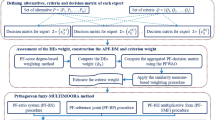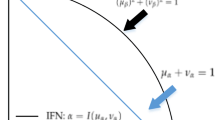Abstract
Big data industry decision is supremely important for companies to boost the efficiency of leadership, which can vastly accelerate industrialized. With regard to big data industry decision assessment, the intrinsic problem involves enormous inexactness, fuzziness and ambiguity. Pythagorean fuzzy sets (PFSs), managing the uncertainness depicted in non-membership with membership, are a quite practical way to capture uncertainness. Firstly, the innovative Pythagorean fuzzy score function is given to dispose the comparison issue. Innovative distance measure and similarity measure for PFSs with three parameters are explored, along with corresponding proofs therewith. Later, objective weight is ascertained by deviation-based method. Also, combined weight is skillfully designed, which can tellingly imply both subjective preference and objective preference. In addition, an approach to settle Pythagorean fuzzy problem by multiparametric similarity measure is presented. The efficacy of developed algorithm is elaborated by a big data industry decision issue. Moreover, a comparison of the introduced algorithm with the selected existing methods has been built on the basis of the division by zero issue and counterintuitive phenomena for displaying its effectiveness.





Similar content being viewed by others
References
Wang H, Xu Z, Pedrycz W, et al. An overview on the roles of fuzzy set techniques in big data processing: Trends, challenges and opportunities. Knowl-Based Syst. 2017;118:15–30.
Ge M, Bangui H, Buhnova B, et al. Big Data for Internet of Things: A Survey. Future Gener Comp Syst. 2018;87:601–14.
Miah SJ, Vu HQ, Gammack J, McGrath M, et al. A big data analytics method for tourist behaviour analysis. Inform Manage. 2017;54:771–85.
Schlick CJR, Castle JP, Bentrem DJ, et al. Utilizing Big Data in Cancer Care. Surg Oncol Clin N Am. 2018;27:641–52.
Ryan HL, Li-Minn A, Seng KP, Broster JC, Pratley JE, et al. Big data and machine learning for crop protection. Comput Electron Agr. 2018;151:376–83.
Zhao L, Chen Z, Hu Y, Min G, Jiang Z, et al. Distributed feature selection for efficient economic big data analysis. IEEE Trans Big Data. 2018;4:164–76.
Atanassov K. Intuitionistic fuzzy sets. Fuzzy Set Syst. 1986;20:87–96.
Zadeh LA. Fuzzy sets. Inf. Control. 1965;8:338–53.
Yager RR. Pythagorean membership grades in multicriteria decision making. IEEE Trans Fuzzy Syst. 2014;22:958–65.
Zhang XL, Xu ZS. Extension of TOPSIS to multiple criteria decision making with Pythagorean fuzzy sets. Int J Intell Syst. 2014;29:1061–78.
Peng XD, Garg H. Multiparametric similarity measures on Pythagorean fuzzy sets with applications to pattern recognition. Appl Intell. 2019;49:4058–96.
Garg H. Confidence levels based Pythagorean fuzzy aggregation operators and its application to decision-making process. Comput Math Organ Th. 2017;23:546–71.
Ma ZM, Xu ZS. Symmetric pythagorean fuzzy weighted geometric/averaging operators and their application in multicriteria decision-making problems. Int J Intell Syst. 2016;31:1198–219.
Khan MSA, Abdullah S, Ali A, Amin F, et al. Pythagorean fuzzy prioritized aggregation operators and their application to multi-attribute group decision making. Granul Comput. 2019;4:249–63.
Gao H, Lu M, Wei G, Wei Y, et al. Some novel Pythagorean fuzzy interaction aggregation operators in multiple attribute decision making. Fund Inform. 2018;159:385–428.
Yang Y, Chen ZS, Chen YH, Chin KS, et al. Interval-valued Pythagorean Fuzzy Frank Power Aggregation Operators based on An Isomorphic Frank Dual Triple. Int J Comput Intell Syst. 2018;11:1091–110.
Qin J. Generalized Pythagorean Fuzzy Maclaurin Symmetric Means and Its Application to Multiple Attribute SIR Group Decision Model. Int J Fuzzy Syst. 2018;20:943–57.
Yang Y, Li YL, Ding H, Qian GS, Lyu HX, et al. The pythagorean fuzzy Frank aggregation operators based on isomorphism Frank t-norm and s-norm and their application. Control Decis. 2018;33:1471–80.
Yang W, Pang Y. New Pythagorean Fuzzy Interaction Maclaurin Symmetric Mean Operators and Their Application in Multiple Attribute Decision Making. IEEE Access. 2018;6:39241–60.
Peng X, Ma X. Pythagorean fuzzy multi-criteria decision making method based on CODAS with new score function. J Intell Fuzzy Syst. 2020;38:3307–18.
Chen TY. Remoteness index-based Pythagorean fuzzy VIKOR methods with a generalized distance measure for multiple criteria decision analysis. Inf Fusion. 2018;41:129–50.
Peng X, Selvachandran G. Pythagorean fuzzy set: State of the art and future directions. Artif Intell Rev. 2019;52:1873–927.
Chen TY. A novel VIKOR method with an application to multiple criteria decision analysis for hospital-based post-acute care within a highly complex uncertain environment. Neural Comput Appl. 2019;31:3969–99.
Chen TY. An outranking approach using a risk attitudinal assignment model involving Pythagorean fuzzy information and its application to financial decision making. Appl Soft Comput. 2018;71:460–87.
Lin M, Huang C, Xu Z, et al. TOPSIS Method Based on Correlation Coefficient and Entropy Measure for Linguistic Pythagorean Fuzzy Sets and Its Application to Multiple Attribute Decision Making. Complexity. 2019;2019:1–16.
Zhan J, Sun B, Zhang X, et al. PF-TOPSIS method based on CPFRS models: An application to unconventional emergency events. Comput Ind Eng. 2020;139:106192.
Peng X. New similarity measure and distance measure for Pythagorean fuzzy set. Complex Intell Syst. 2019;5:101–11.
Chen SM. Similarity measures between vague sets and between elements. IEEE Trans Syst Man Cyber. 1997;27:153–8.
Chen SM, Chang CH. A novel similarity measure between Atanssov’s intuitionistic fuzzy sets based on transformation techniques with applications to pattern recognition. Inf Sci. 2015;291:96–114.
Hong DH, Kim C. A note on similarity measures between vague sets and between elements. Inf Sci. 1999;115:83–96.
Li F, Xu ZY. Measures of similarity between vague sets. J Softw. 2001;12:922–7.
Liang ZZ, Shi PF. Similarity measures on intuitionistic fuzzy sets. Pattern Recognit Lett. 2003;24:2687–93.
Mitchell HB. On the Dengfeng-Chuntian similarity measure and its application to pattern recognition. Pattern Recognit Lett. 2003;24:3101–4.
Ye J. Cosine similarity measures for intuitionistic fuzzy sets and their applications. Math Comput Model. 2011;53:91–7.
Keshavarz GM, Zavadskas EK, Amiri M, Antucheviciene J, et al. A new method of assessment based on fuzzy ranking and aggregated weights (AFRAW) for MCDM problems under type-2 fuzzy environment. Econ Comput Econ Cyb. 2016;50:39–68.
Wang X, Triantaphyllou E. Ranking irregularities when evaluating alternatives by using some electre methods. Omega. 2008;36:45–63.
Lin M, Huang C, Xu Z, Chen R, et al. Evaluating IoT Platforms Using Integrated Probabilistic Linguistic MCDM Method. IEEE Internet Things. 2020. https://doi.org/10.1109/JIOT.2020.2997133.
Funding
This study was funded by National Natural Science Foundation of China (grant number 62006155), MOE (Ministry of Education in China) Project of Humanities and Social Sciences (grant number 18YJCZH054), Natural Science Foundation of Guangdong Province (grant number 2018A030307033), and the General Project of Shaoguan University (grant number SY2016KJ11).
Author information
Authors and Affiliations
Corresponding author
Ethics declarations
Conflicts of Interest
The authors declare that they have no conflict of interest.
Ethical Standard
This article does not contain any studies with human participants or animals performed by any of the authors.
Rights and permissions
About this article
Cite this article
Peng, X., Yuan, H. Pythagorean Fuzzy Multi-Criteria Decision Making Method Based on Multiparametric Similarity Measure. Cogn Comput 13, 466–484 (2021). https://doi.org/10.1007/s12559-020-09781-x
Received:
Accepted:
Published:
Issue Date:
DOI: https://doi.org/10.1007/s12559-020-09781-x




